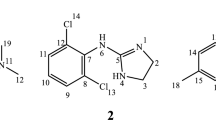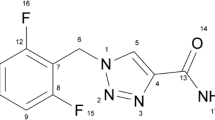Abstract
The thiazolobenzimidazole l-(2,6-difluorophenyl)-lH,3H-thiazolo[3,4-a]benzimidazole, TBI, is an experimental drug for the treatment of AIDS which exhibits a low water solubility (11 µg/mL) and is therefore difficult to administer in an injectable solution dosage form at a target solution concentration of 10 mg/mL. The compound has a single ionizable functional group and exhibits an increase in solubility with decreasing pH consistent with a pK a of 3.55, but the maximum solubility attainable by pH adjustment has been shown to be only 0.4 mg/mL (at pH 2). TBI has been found to form inclusion complexes in either its neutral or its protonated form with 2-hydroxypropyl-β-cyclodextrin (HPCD). The equilibrium constants for 1:1 complex formation were found to be 81 and 1033 M −l for the protonated and neutral species, respectively. Although the formation of protonated complex is less favored in comparison to the neutral complex, the contribution of this species to the overall solubility of TBI predominates at low pH. Thus, using a combined approach of pH adjustment and complexation with HPCD, a solubility enhancement of 3 orders of magnitude is possible. NMR proton spectroscopy and molecular modeling studies, conducted to understand the orientation of TBI in the complex and the effect of protonation, are described.
Similar content being viewed by others
REFERENCES
D. J. W. Grant and T. Higuchi. Solubility Behavior of Organic Compounds. John Wiley & Sons, New York, 1990.
S. H. Yalkowsky. Techniques of Solubilization of Drugs, Marcel Dekker, New York, 1981.
D. D. Perrin and B. Dempsey. Buffers for pH and Metal Ion Control, Halsted Press, New York, 1979.
K. Lindner and W. Saenger. Crystal and molecular structure of cyclohepta-amylose dodecahydrate. Carbohydr. Res. 99:103–115 (1982).
Y. C. J. Wang and R. R. Kowal. Review of excipients and pH's for parenteral products used in the United States. J. Parent. Drug Assoc. 34:4452–4462 (1980).
A. Cheung. NCI Contract No. NO1-CM-67864 Report, Feb. 6, 1991.
R. L. VanEtten, G. A. Clowes, J. F. Sebastian, and M. J. Bender. Acceleration of phenyl ester cleavage by cycloamyloses. A model for enzymatic specificity. J. Am. Chem. Soc. 89:3242–3253 (1967).
Author information
Authors and Affiliations
Rights and permissions
About this article
Cite this article
Tinwalla, A.Y., Hoesterey, B.L., Xiang, Tx. et al. Solubilization of Thiazolobenzimidazole Using a Combination of pH Adjustment and Complexation with 2-Hydroxypropyl-β-Cyclodextrin. Pharm Res 10, 1136–1143 (1993). https://doi.org/10.1023/A:1018908032686
Issue Date:
DOI: https://doi.org/10.1023/A:1018908032686




